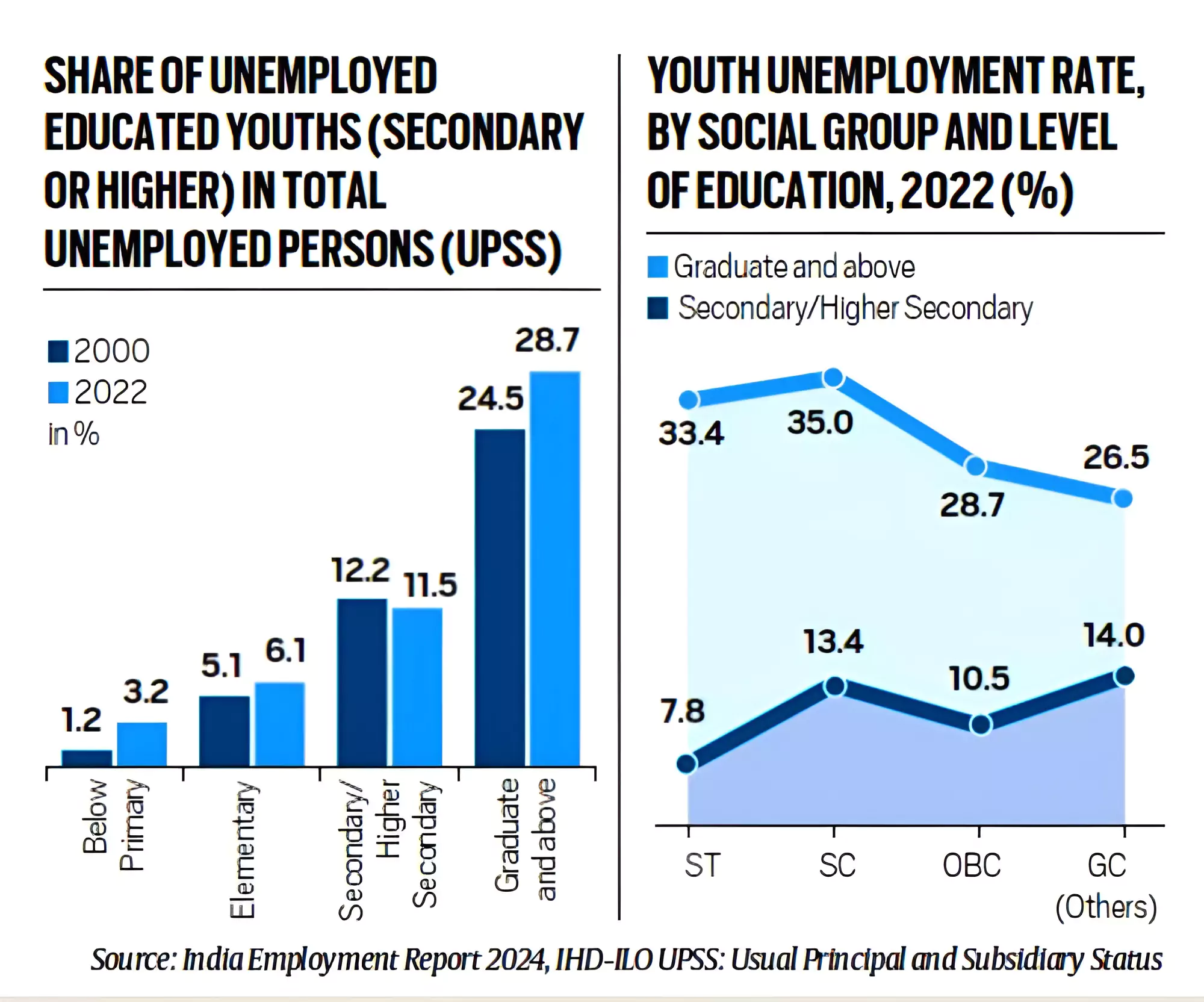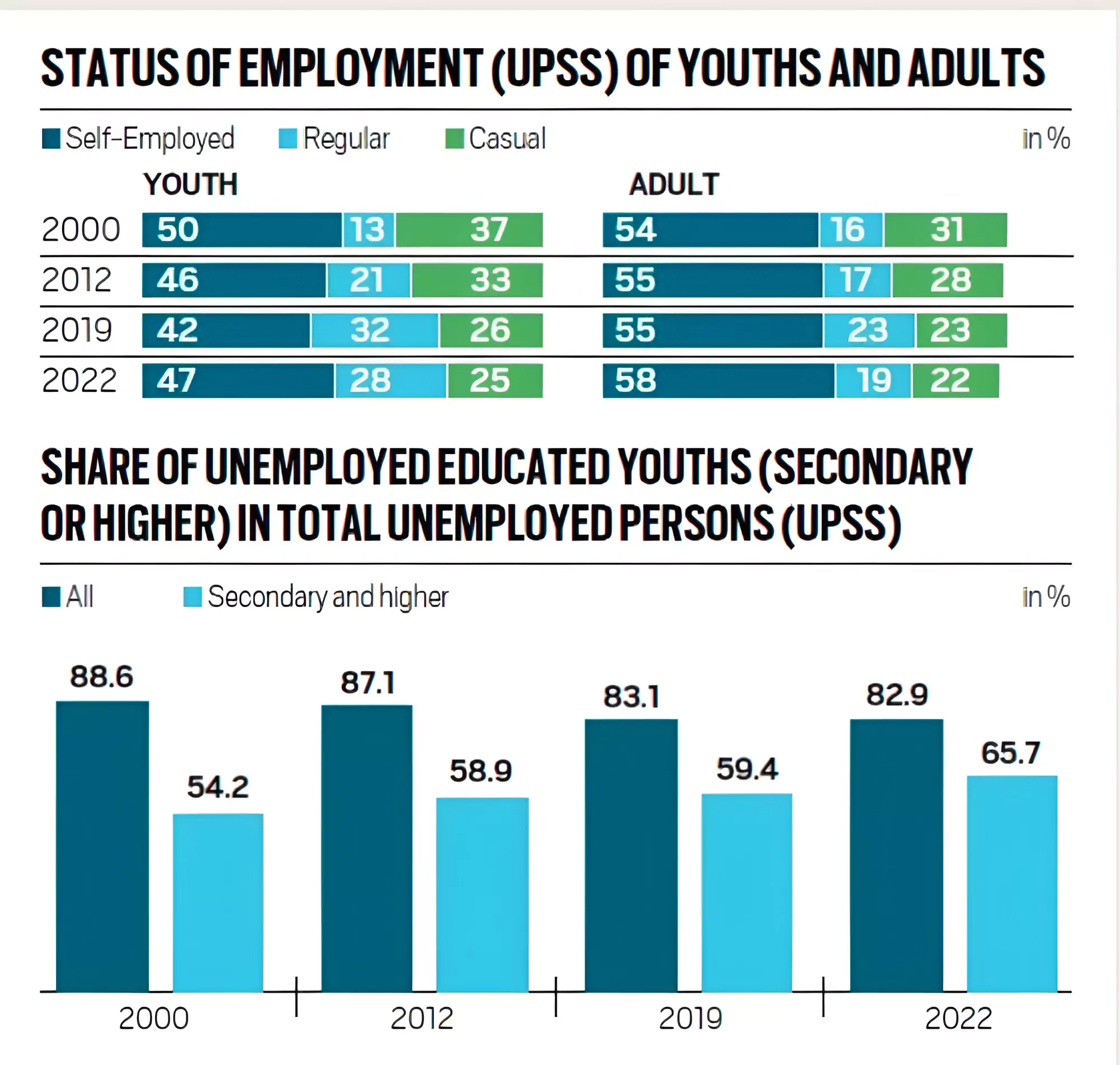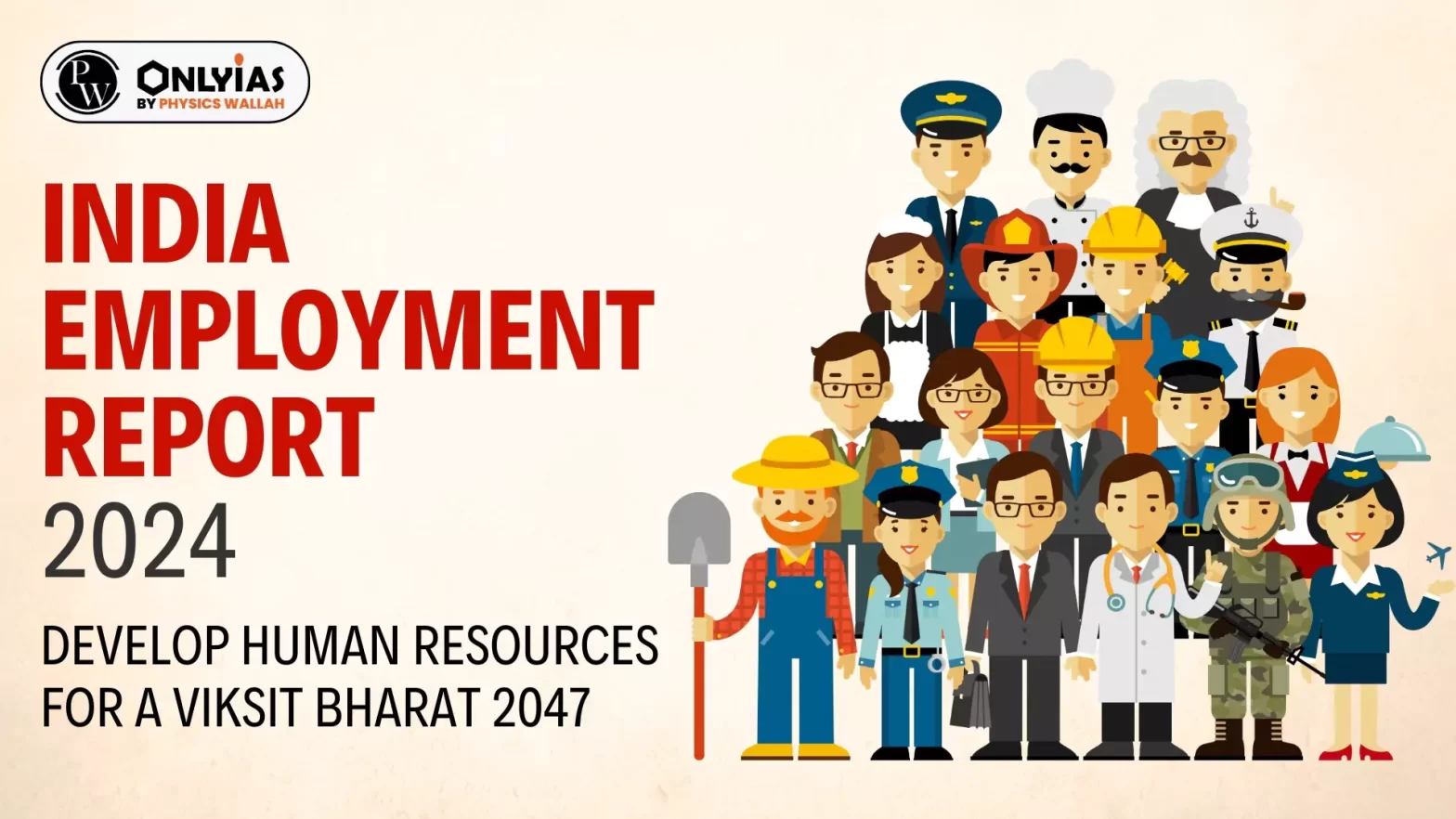Context
Recently, the Indian finance minister mentioned that not satisfying outcomes emerged from the recently released India Employment Report 2024 and to achieve the aim of Visit Bharat, India needs an inclusive growth at an annual average of about 8%.
Vision for Viksit Bharat 2047: Key Highlights
- In the Interim Budget, the Indian Finance Minister said that the government’s vision for ‘Viksit Bharat’ is that of a “prosperous Bharat in harmony with nature, with modern infrastructure, and providing opportunities for all citizens and all regions to reach their potential”.
- To achieve this goal of ‘Viksit Bharat’, there is a need to improve people’s capability and empower them.
- Targets for Developed India:
- On Gross Domestic Product (GDP): The proposed measures should boost India’s GDP to $6.69 trillion in 2030, $16.13 trillion by 2040, and $29.02 trillion by 2047.
- On Per Capita Income: The projections for per capita income at current prices are $4,418 by 2030, $10,021 by 2040, and $17,590 by 2047.
- It means the present per capita income of about Rs 2 lakhs will become about Rs 14.9 Lakhs by 2047.
- On Exports: Export targets are $1.58 trillion by value in 2030, $4.56 trillion by 2040, and $8.67 trillion by 2047.
India Employment Report 2024
- Recently, the International Labour Organisation (ILO) and the Institute of Human Development (IHD) have released a report named “India Employment Report 2024”.
About the Institute of Human Development (IHD)
- Established: The Institute for Human Development (IHD) was established in 1998 by the Indian Society of Labour Economics (ISLE).
- Aims: To help establish a society that promotes and supports an inclusive social, economic, and political system free of poverty and deprivation.
- Research: It researches labour and employment, livelihoods, gender, health, education, and other areas of human development.
About the International Labor Organization
- International Labour Organisation (ILO) is the only tripartite United Nations (UN) agency.
- It brings together governments, employers and workers of 187 Member States (India is a member) to set labour standards, develop policies and devise programmes promoting decent work for all women and men.
- Establishment: In 1919, by the Treaty of Versailles.
- It became the first specialised agency of the UN in 1946.
- Headquarters: Geneva, Switzerland
- Award: It received the Nobel Peace Prize in 1969.
|
About India Employment Report 2024
- Basis of Report: The research is mostly based on data analysis from the National Sample Surveys and Periodic Labour Force Surveys conducted between 2000 and 2022.
- Indicators Used: The index is based on seven labour market outcome indicators:
- Percentage of workers employed in regular formal work
- Percentage of casual labourers
- Percentage of self-employed workers below the poverty line
- Work Participation Rate
- Average monthly earnings of casual labourers
- Unemployment rate of secondary and above-educated youth
- Youth not in employment and education or training
Key Highlights of the India Employment Report 2024
-
Improvement in the “Employment Condition Index”:
- The ‘employment condition index’ has improved between 2004-05 and 2021-22 with Delhi, Himachal Pradesh, Telangana, Uttarakhand and Gujarat having stayed at the top.
- But some states — Bihar, Odisha, Jharkhand, and UP have remained at the bottom throughout this period.
-
Improvement in the Employment Quality:

-
- Self-employment remains the primary source of employment — 55.8% in 2022. Casual and regular employment accounted for 22.7% and 21.5% respectively.
- Regular Employment: It is generally seen as providing better-quality jobs due to the regularity of employment and associated social security benefits.
- Casual Work: It is linked with relatively poor-quality jobs due to its irregular nature and lower daily earnings.
- Informal Employment: The number of jobs in the formal sector has risen, and around half of them are informal.
- Almost 82% of the workforce is engaged in the informal sector, and nearly 90% is informally employed.
- Self-employment and unpaid family work have also increased, especially for women.
-
Fluctuating Employment in Agriculture:
- The slow transition towards non-farm employment has been reversed after 2018-19. The share of agriculture in total employment fell to around 42% in 2019 from 60% in 2000.
- This shift was primarily absorbed by construction and services, the share of which in total employment increased to 32% in 2019 from 23% in 2000. The share of manufacturing in employment has remained almost stagnant at 12-14%.
- Since 2018-19, this slow transition has stagnated or reversed with the rise in the share of agricultural employment.
-
Impact of Artificial Intelligence (AI):
- The rise of AI could have an impact on employment. The outsourcing industry in India could be disrupted because AI would take over some back-office tasks.
About Viksit Bharat 2047
- ‘Viksit Bharat’ means ‘developed India’, a vision the government aims to realise by 2047 — the year India completes 100 years of independence.
- Aim: To turn India into a $30-trillion developed economy in about two decades for a projected 1.65 billion population.
- Inclusive Growth: The document envisions economic growth, sustainable development goals, improvements in the ease of living and doing business, enhanced infrastructure, and bolstered social welfare initiatives.
- Four Pillars: Yuva (Youth), Garib (Poor), Mahila (Women) and Kisan (Framers).
-
Key Theme of Viksit Bharat:
- Empowered Indians (Health, Education, Nari Shakti, Sports, Culture and Caring Society)
- Thriving and Sustainable Economy (Industry, Energy, Agriculture, Infrastructure, Services, Green Economy and Cities)
- Innovation, Science and Technology (Research and Development, Startups and Digital)
- Good Governance and Security
- India in the World
-
Key Focus Areas:
-
- Education: Upgrading school infrastructure, boosting the number of students attending schools, and elevating educational standards.
- Healthcare: Guaranteeing that every citizen has access to healthcare services that are both reachable and of high quality.
- Technology: Adopting and pioneering technological solutions for national advancement.
- Infrastructure: Building strong infrastructure such as for transportation, communication networks, and city facilities.
- Agriculture: Introducing advanced agricultural practices and providing support to farmers to augment their output and productivity.
- Environment: Advancing eco-friendly methods and safeguarding our natural assets to ensure the environment is both clean and thriving for future generations.
To Achieve Viksit Bharat, Need to Develop Human Resources
- Human Resource Development (HRD): HRD refers to the systematic approach to nurturing and fostering the talents, competencies, and skills of individuals, thereby contributing to national development.
How to Develop Human Resources?
- Education and Skill Development: There is a need to transform the education system to prioritize practical skills and problem-solving over memorization.
- Project-Based Learning: Finland’s education system is a notable example where project-based learning has been implemented successfully, fostering a culture of creativity and critical thinking among students. India could borrow cues from such models to nurture a problem-solving approach.
- Industry-Academia Collaboration: The collaboration between IIT Madras and various industries is a testament to the potential of symbiotic relationships between academia and industry, where theoretical learning meets practical demands, enhancing employability prospects.
- Skill and Workforce Enhancement: Extend skill development programs across industries and offer credible certifications.
- Continuous Professional Development: Singapore has an integrated system for continuous teacher training and development. India could learn by encouraging teachers to engage in lifelong learning and adapt to evolving educational landscapes.
- Health and Wellbeing: Ensure affordable, quality healthcare with robust infrastructure.
- Telemedicine: The successful implementation of telemedicine in states like Kerala during the COVID-19 pandemic demonstrated how technology can be utilized to bridge healthcare gaps, presenting a viable model for other states to follow.
- Addressal to Malnutrition: The Amma Unavagam initiative in Tamil Nadu is a stellar example where community kitchens have been utilized to address malnutrition while also supporting local farmers.
- Research, Innovation, and Technology Adoption: Invest in research to drive innovation and foster ties between academia and industry.
- Example: ISRO established the National Research Foundation.
- Incubation Centres: The success stories coming from incubation centres like those at IIT Bombay signify the potential of fostering innovation at the educational institutional level, thus promoting research and development.
- Bridge Digital Divide: Initiatives such as the digital bus project in Maharashtra have showcased the efficacy of mobile education units in bridging the digital divide and promoting digital literacy.
- Gender Equality and Social Inclusion: Promote gender equality in education and employment through policies and incentives.
- Mentorship Programs: Mentorship programs like those initiated by organizations such as the WISE (Women in Science and Engineering) in various countries could serve as an exemplary model to foster gender equality in the academic and professional spheres.
- Skill Festivals: Countries like Germany have showcased the efficacy of promoting vocational training through festivals and fairs, where individuals get a platform to exhibit their vocational skills and learn about diverse career avenues.
- Various Schemes: The Ministry of Education (MoE) in India also has various schemes for human resource development.
- Some of these schemes include the Samagra Shiksha Scheme to provide quality education in Madrasas, the Mid-Day Meal Scheme, the National Achievement Survey (NAS), and Infrastructure Development in Minority Institutes (IDMI).
- Various other government initiatives related to human development are PM Kaushal Vikas Yojna, SHREYAS Scheme, Startup India, New Education Policy, 2020, Pradhan Mantri Jeevan Jyoti Bima Yojana (PMJJBY), Women in Engineering, Science, and Technology (WEST) Initiative, etc.
Challenges that Need to be Addressed to Achieve Inclusive Viksit Bharat

- Rising Population Growth and Demographic Changes.
- Example: 33% of India’s population is aged 20-29 in 2024, but by 2047, the proportion of younger and older working-age populations will both be around 28%.
- There are also challenges of infrastructure, inequalities and high gender gap.
- Other challenges: Concerns raised by the India Employment Report 2024:
- Concern of Poor Employment Conditions:
- The slow transition to non-farm employment has reversed.
- Women largely account for the increase in self-employment and unpaid family work.
- Youth employment is of poorer quality than employment for adults.
- Wages and earnings are stagnant or declining.
- Less Participation of Women Workforce: India’s female labour force participation rate (LFPR) remains among the world’s lowest.
- High Gender Gap: Women’s LFPR (32.8%) in 2022 was 2.3 times lower than men’s (77.2%).
- India’s low LFPR is largely due to the low female LFPR, which was much lower than the world average of 47.3% in 2022, but higher than the South Asian average of 24.8%.
- Improvement Observed: Female LFPR declined by 14.4% points between 2000 and 2019 but raised by 8.3% points between 2019 and 2022.
- Challenges of Youth Employment: There has been a rise in youth employment, but the quality of work remains a concern, especially for qualified young workers.
- The unemployment rate among educated youths grew to 30.8% in 2019 from 23.9% in 2000, but fell to 18.4% in 2022.
- In 2022, the share of unemployed youths in the total unemployed population was 82.9%. The share of educated youths among all unemployed people also increased to 65.7% in 2022 from 54.2% in 2000.
- The unemployment rate among youths was six times greater for those who had completed secondary education or higher (18.4%) and nine times higher for graduates (29.1%) than for persons who could not read or write (3.4%) in 2022.
- This was higher among educated young women (21.4%) than men (17.5%), especially among female graduates (34.5%), compared to men (26.4%).
Way Forward
- Focus on Five Key Policy Areas: Promoting job creation; improving employment quality; addressing labour market inequalities; strengthening skills and active labour market policies; and bridging the knowledge deficits on labour market patterns and youth employment.
- Investment and Regulations: These are required in the emerging care and digital economies.
- The lack of job security, irregular wages, and uncertain employment status for workers pose significant challenges for gig or platform work.
- Enhancement of Policies: Economic policies are required to boost productive non-farm employment, especially in the manufacturing sector, with India likely to add 7-8 mn youths annually to the labour force during the next decade.
- Digital Support: More support needs to be provided to micro, small and medium-sized enterprises, especially by providing tools such as digitalisation and AI and a cluster-based approach to manufacturing.
- Overall Development: Economic growth, social and environmental development are correlated and important to improve the basic living conditions of the population and Country.
- Reach, Range and Reason Based (3R) Policies: Amartya Sen said that to achieve development, government policies must focus on the 3 R’s:
- Reach (reach of the reason to be achieved)
- Range (ways and means to be used)
- Reason (priority to pursue)
- Social-Economic Inclusion: Equality of opportunity under Article 14 of Indian Constitution must be ensured by closing the gender gap and achieving the Sustainable Development Goals.
- Development of Social Infrastructure: A universal education and health care system with improved quality of life and skill development is a desired and required need to attain the goal of Viksit Bharat.
- Focus on Agriculture: Agriculture is critical for India’s development as it still engages about 45% of the working population (2022-23, PLFS data). So, if Viksit Bharat has to be an inclusive Bharat, it must develop its agriculture to its full potential.
- Productivity needs to rise, water consumption needs to be reduced, groundwater needs to be re-charged, soil degradation needs to be arrested, and greenhouse gas (GHG) emissions from agriculture need to be curtailed.
Conclusion
To achieve the dream of Viksit Bharat 2047, India needs to continuously work upon human development through quality education and skill formation, creating a supportive ecosystem for research and innovation, coupled with liberal market policies, investments and innovations. However, the only warning is that there is no Covid type disease outbreak, or a major war, natural calamity, or political upheaval.
Also Read: Vision India@2047
| Prelims PYQ (2020):
With reference to the Indian economy after the 1991 economic liberalization, consider the following statements:
1. Worker productivity (rs. per worker at 2004 -05 prices) increased in urban areas while it decreased in rural areas.
2. The percentage share of rural areas in the workforce steadily increased.
3. In rural areas, the growth in non -farm economy increased.
4. The growth rate in rural employment decreased Which of the statements given above is/are correct? (a) 1 and 2 only (b) 3 and 4 only (c) 3 only (d) 1, 2 and 4 only
Ans: (b) |
To get PDF version, Please click on "Print PDF" button.


